英语教师教学论文初中英语教学案例分析
- 格式:doc
- 大小:15.50 KB
- 文档页数:2
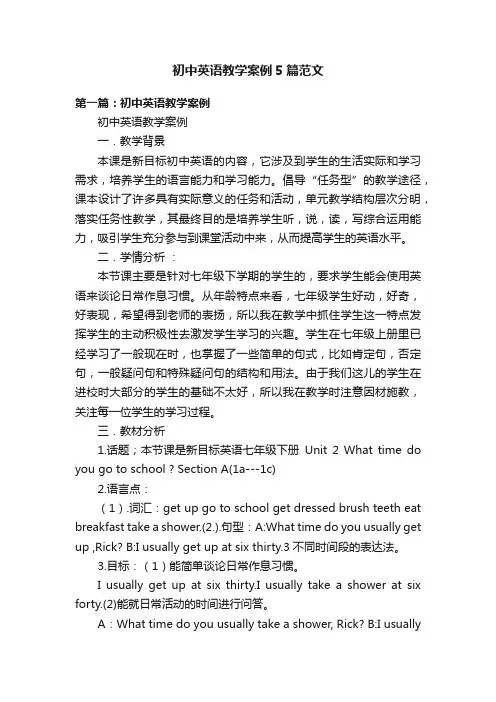
初中英语教学案例5篇范文第一篇:初中英语教学案例初中英语教学案例一.教学背景本课是新目标初中英语的内容,它涉及到学生的生活实际和学习需求,培养学生的语言能力和学习能力。
倡导“任务型”的教学途径,课本设计了许多具有实际意义的任务和活动,单元教学结构层次分明,落实任务性教学,其最终目的是培养学生听,说,读,写综合运用能力,吸引学生充分参与到课堂活动中来,从而提高学生的英语水平。
二.学情分析:本节课主要是针对七年级下学期的学生的,要求学生能会使用英语来谈论日常作息习惯。
从年龄特点来看,七年级学生好动,好奇,好表现,希望得到老师的表扬,所以我在教学中抓住学生这一特点发挥学生的主动积极性去激发学生学习的兴趣。
学生在七年级上册里已经学习了一般现在时,也掌握了一些简单的句式,比如肯定句,否定句,一般疑问句和特殊疑问句的结构和用法。
由于我们这儿的学生在进校时大部分的学生的基础不太好,所以我在教学时注意因材施教,关注每一位学生的学习过程。
三.教材分析1.话题;本节课是新目标英语七年级下册Unit 2 What time do you go to school ? Section A(1a---1c)2.语言点:(1).词汇:get up go to school get dressed brush teeth eat breakfast take a shower.(2.).句型:A:What time do you usually get up ,Rick? B:I usually get up at six thirty.3不同时间段的表达法。
3.目标:(1)能简单谈论日常作息习惯。
I usually get up at six thirty.I usually take a shower at six forty.(2)能就日常活动的时间进行问答。
A:What time do you usually take a shower, Rick? B:I usuallytake a shower at six forty.4、教具准备录音机,时钟,图片洗澡,起床,跑步,吃早餐,上学等动作的图片并将英语单词写在图片的下方。
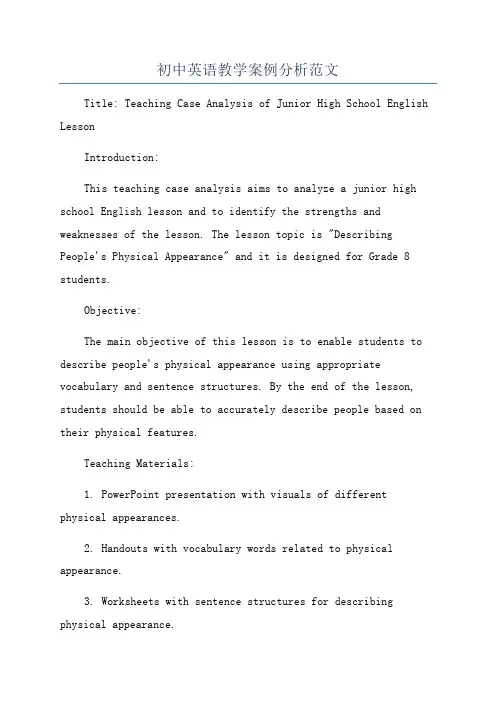
初中英语教学案例分析范文Title: Teaching Case Analysis of Junior High School English LessonIntroduction:This teaching case analysis aims to analyze a junior high school English lesson and to identify the strengths and weaknesses of the lesson. The lesson topic is "Describing People's Physical Appearance" and it is designed for Grade 8 students.Objective:The main objective of this lesson is to enable students to describe people's physical appearance using appropriate vocabulary and sentence structures. By the end of the lesson, students should be able to accurately describe people based on their physical features.Teaching Materials:1. PowerPoint presentation with visuals of different physical appearances.2. Handouts with vocabulary words related to physical appearance.3. Worksheets with sentence structures for describing physical appearance.4. Original conversation dialogue for role-play.Lesson Plan:I. Warm-up Activity (10 minutes):- Show pictures of famous celebrities and ask students to describe their physical appearance.- Discuss the importance of physical appearance in various contexts.II. Introduction to Vocabulary (15 minutes):- Present vocabulary words related to physical appearance using the PowerPoint presentation.- Provide examples and ask students to repeat after the teacher to practice pronunciation.III. Vocabulary Practice (15 minutes):- Hand out worksheets with vocabulary exercises.- Check answers as a class and clarify any misunderstandings.IV. Introduction to Sentence Structures (10 minutes):- Present sentence structures for describing physical appearance.- Use visual cues and provide examples to reinforce understanding.V. Sentence Structure Practice (20 minutes):- Divide students into pairs.- Give each pair a different picture of a person.- Students take turns describing the person's physical appearance using the sentence structures.- Encourage students to ask follow-up questions to gather more information.VI. Role-play Activity (15 minutes):- Provide each pair with a dialogue script for role-play.- Students take turns playing the role of a customer and a shop assistant.- The dialogue focuses on describing physical appearance to find suitable clothes.VII. Consolidation and Assessment (10 minutes):- Ask students to write a short paragraph describing their best friend's physical appearance.- Collect the paragraphs for assessment purposes.VIII. Conclusion and Reflection (5 minutes):- Recap the main points of the lesson.- Ask students to discuss what they have learned and any difficulties they encountered.Strengths of the Lesson:1. The lesson includes a variety of activities such asvisual presentations, pair work, and role-plays, which engage different learning styles and keep students motivated.2. The use of visuals and real-life examples helps students understand and remember the new vocabulary and sentence structures.3. The assessment task requires students to apply what they have learned in a meaningful way.Weaknesses of the Lesson:Conclusion:This teaching case analysis has demonstrated that the lesson on describing people's physical appearance has several strengths in engaging students and facilitating their learning process. However, there are also some weaknesses that need to be addressed in order to enhance the effectiveness of the lesson. By taking the strengths and weaknesses into consideration,future lessons can be improved to better meet the learning needs of the students.。
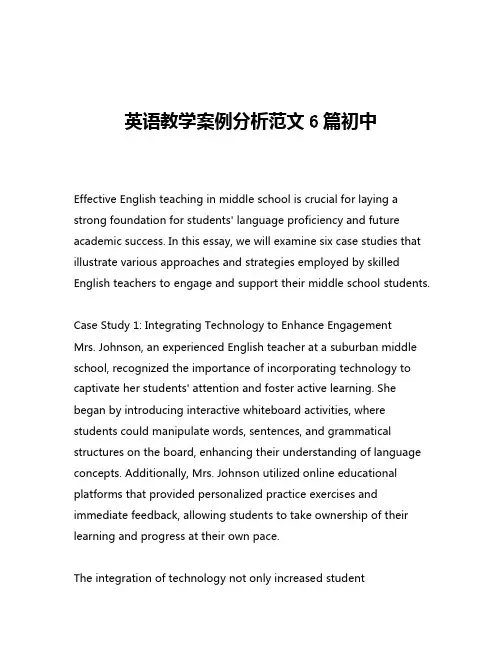
英语教学案例分析范文6篇初中Effective English teaching in middle school is crucial for laying a strong foundation for students' language proficiency and future academic success. In this essay, we will examine six case studies that illustrate various approaches and strategies employed by skilled English teachers to engage and support their middle school students.Case Study 1: Integrating Technology to Enhance Engagement Mrs. Johnson, an experienced English teacher at a suburban middle school, recognized the importance of incorporating technology to captivate her students' attention and foster active learning. She began by introducing interactive whiteboard activities, where students could manipulate words, sentences, and grammatical structures on the board, enhancing their understanding of language concepts. Additionally, Mrs. Johnson utilized online educational platforms that provided personalized practice exercises and immediate feedback, allowing students to take ownership of their learning and progress at their own pace.The integration of technology not only increased studentengagement but also enabled Mrs. Johnson to differentiate instruction and cater to diverse learning styles. Students who struggled with traditional pen-and-paper exercises found the digital activities more appealing and accessible, while those who thrived on independent learning benefited from the self-paced nature of the online resources. The result was a more dynamic and inclusive classroom environment, where all students felt empowered to participate and succeed in their English studies.Case Study 2: Fostering Critical Thinking through Literature Circles Mr. Patel, a middle school English teacher in a diverse urban setting, recognized the importance of developing his students' critical thinking skills. He implemented a literature circles approach, where students were divided into small groups and assigned different roles, such as discussion leader, connector, and literary analyst. Each group was responsible for reading a selected work of literature and engaging in collaborative discussions to unpack the themes, characters, and literary devices.The literature circles not only encouraged active engagement with the text but also cultivated essential communication and problem-solving skills. Students learned to listen actively, express their ideas clearly, and consider multiple perspectives. Mr. Patel's role shifted from a traditional lecturer to a facilitator, guiding the discussions and prompting students to delve deeper into the literary analysis.The success of this approach was evident in the students' increased confidence in expressing their interpretations and the depth of their literary analysis. Additionally, the collaborative nature of the literature circles fostered a sense of community and camaraderie among the students, further enhancing their overall learning experience.Case Study 3: Integrating Authentic Cultural ExperiencesIn a middle school with a growing population of English language learners, Ms. Garcia recognized the importance of incorporating authentic cultural experiences into her English lessons. She collaborated with the school's diversity committee to organize cultural celebrations and invite guest speakers from various backgrounds to share their stories and traditions.During these events, students had the opportunity to engage with the English language in a meaningful and contextual manner. They learned vocabulary and expressions related to the featured cultures, participated in interactive activities, and gained a deeper appreciation for the diversity within their school community. The cultural experiences also served as a platform for students to practice their speaking and listening skills in a low-stress, authentic setting.The integration of authentic cultural experiences not only improvedthe English language proficiency of the English language learners but also fostered a greater sense of inclusion and understanding among all students. The cross-cultural exchange and exposure to diverse perspectives enriched the learning environment and contributed to the overall growth and development of the students.Case Study 4: Differentiated Instruction for Struggling Readers Mrs. Nguyen, a middle school English teacher in a high-needs district, recognized the diverse learning needs of her students, particularly those who struggled with reading comprehension. She implemented a multi-tiered system of support, where she provided targeted interventions and differentiated instruction to address the individual needs of her students.For students who required additional support, Mrs. Nguyen utilized research-based reading strategies, such as guided reading, vocabulary development, and explicit instruction in phonics and fluency. She also incorporated the use of audiobooks, text-to-speech software, and graphic organizers to help struggling readers access the content and actively engage with the material.Mrs. Nguyen's dedication to differentiated instruction paid off, as her struggling readers demonstrated significant improvements in their reading abilities and overall academic performance. The individualized attention and tailored support not only boosted theirconfidence but also instilled a love for reading and learning.Case Study 5: Integrating Project-Based LearningMr. Goldstein, a middle school English teacher in a suburban setting, recognized the importance of making the English curriculum more relevant and engaging for his students. He implemented a project-based learning approach, where students were tasked with creating multimedia presentations on topics of their choice, ranging from social issues to literary analyses.The project-based learning approach allowed students to take an active role in their learning, as they conducted research, synthesized information, and utilized various technological tools to present their findings. Mr. Goldstein provided guidance and feedback throughout the process, ensuring that students developed essential skills, such as critical thinking, problem-solving, and effective communication.The project-based learning activities not only enhanced the students' engagement and motivation but also fostered their ability to collaborate, think creatively, and apply their knowledge to real-world situations. The final presentations showcased the students' diverse talents and perspectives, further enriching the learning environment.Case Study 6: Integrating Interdisciplinary ConnectionsMs. Lim, a middle school English teacher in a STEM-focused school,recognized the importance of integrating interdisciplinary connections to make the English curriculum more relevant and meaningful for her students. She collaborated with her colleagues from the science, mathematics, and social studies departments to develop cross-curricular lessons and projects.For example, in a unit on persuasive writing, Ms. Lim worked with the science teacher to have students research and write persuasive essays on environmental issues. The students not only honed their English language skills but also deepened their understanding of scientific concepts and their real-world applications. Similarly, in a poetry unit, Ms. Lim partnered with the art teacher to have students create visual representations of their poems, fostering their creativity and artistic expression.The integration of interdisciplinary connections not only enhanced the relevance and depth of the English curriculum but also encouraged students to see the interconnectedness of different subject areas. This approach helped students develop a more holistic understanding of the world around them and the role of language in various disciplines.In conclusion, the six case studies presented in this essay demonstrate the diverse and effective strategies employed by skilled English teachers in middle school settings. From integratingtechnology to fostering critical thinking, incorporating authentic cultural experiences, differentiating instruction, implementing project-based learning, and making interdisciplinary connections, these teachers have created dynamic and inclusive learning environments that support the academic and personal growth of their students. The success of these approaches underscores the importance of continuous professional development, collaboration, and a student-centered approach to English language instruction in middle schools.。
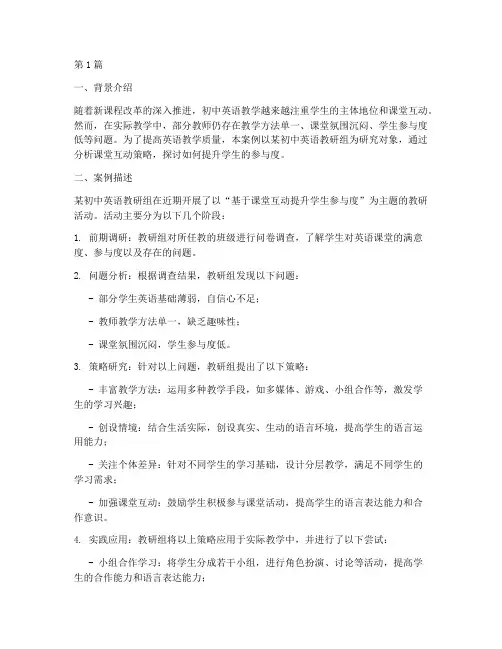
第1篇一、背景介绍随着新课程改革的深入推进,初中英语教学越来越注重学生的主体地位和课堂互动。
然而,在实际教学中,部分教师仍存在教学方法单一、课堂氛围沉闷、学生参与度低等问题。
为了提高英语教学质量,本案例以某初中英语教研组为研究对象,通过分析课堂互动策略,探讨如何提升学生的参与度。
二、案例描述某初中英语教研组在近期开展了以“基于课堂互动提升学生参与度”为主题的教研活动。
活动主要分为以下几个阶段:1. 前期调研:教研组对所任教的班级进行问卷调查,了解学生对英语课堂的满意度、参与度以及存在的问题。
2. 问题分析:根据调查结果,教研组发现以下问题:- 部分学生英语基础薄弱,自信心不足;- 教师教学方法单一,缺乏趣味性;- 课堂氛围沉闷,学生参与度低。
3. 策略研究:针对以上问题,教研组提出了以下策略:- 丰富教学方法:运用多种教学手段,如多媒体、游戏、小组合作等,激发学生的学习兴趣;- 创设情境:结合生活实际,创设真实、生动的语言环境,提高学生的语言运用能力;- 关注个体差异:针对不同学生的学习基础,设计分层教学,满足不同学生的学习需求;- 加强课堂互动:鼓励学生积极参与课堂活动,提高学生的语言表达能力和合作意识。
4. 实践应用:教研组将以上策略应用于实际教学中,并进行了以下尝试:- 小组合作学习:将学生分成若干小组,进行角色扮演、讨论等活动,提高学生的合作能力和语言表达能力;- 游戏教学:设计趣味性强的英语游戏,让学生在游戏中学习英语,提高学习兴趣;- 情境教学:结合教材内容,创设真实、生动的情境,让学生在情境中运用英语;- 课堂提问:采用多种提问方式,激发学生的思考,提高学生的参与度。
5. 效果评估:经过一段时间的实践,教研组对学生的英语学习情况进行了跟踪调查,发现以下变化:- 学生的英语成绩有所提高;- 学生对英语课堂的满意度明显提升;- 学生的参与度明显提高,课堂氛围活跃。
三、案例分析本案例通过分析课堂互动策略,探讨了如何提升学生的参与度。

英语教学论文及案例分析第一篇:英语教学论文及案例分析如何巧妙设计英语课堂提问合适的课堂提问,是一门艺术,它往往能把学生带入一个奇妙的问题世界,使学生积极思考问题,寻求解决问题的途径和答案,从而培养学生分析问题、解决问题的能力,有效地提高英语课堂教学效率。
对于缺乏自制能力的学生来说,有效而恰当的提问,更能起到意想不到的作用。
下面是我结合自己的课堂教学,试着从几方面对如何有效恰当的课堂提问进行了探讨:一、注重提问的原则(一)启发思维的原则教师的提问,应富有启发性。
因为课堂提问本身不是目的,而是启发学生思维的手段。
不能为提问而提问、教师必须明确,提问不等于启发式,好的提问才是启发式提问,启发式提问重在所提问有价值和有意义,能够引导学生积极思考,发展其思维能力。
如:我讲授三——六年级英语提问时就不是很注重启发学生的思维,只是机械的训练学生的口语,回顾旧知。
所以今后的提问应该注意启发学生的思维,让学生形成良好的行为习惯。
(二)激发兴趣的原则学生学习的内在动力是学习兴趣,应此教师提问如果能激发学生的学习动机和兴趣,他们就有了学习的原动力,这是启发教学的关键。
为此,教师必须从教材和学生心理特点出发,引人入胜地、步步深入地提出富有趣味性、启发性的问题,用科学的、艺术的、生动的语言,吸引学生去积极思维。
(三)难易适度的原则课堂提问必须做到难易适度,尤其是难度较大的问题,一定要设计成一系列由浅入深,由旧导新、从易到难的小问题,使学生通过问题解答,逐步突破难点,把握要领,掌握规律。
如:我在教授五年级牛津英语的时候,刚开始上课时,我总是把低年级学的一些简单的常用语(How are you ?How old are you?)等来提问,让学生有些许成就感,继而不断提高难度引导学生回忆Which …句型,把本课时的重点分解开来,生在不知不觉中就把知识学到手了。
二、注重学生主体性素质教育主张以“学生的学”为中心,把学生真正当作学习的主体,在英语课堂教学中根据实际情况,灵活地采用各种提问方式,既可活跃课堂气氛,激发学生提问的积极性,又可扩大提问的面,增加学生练习的时间和机会。
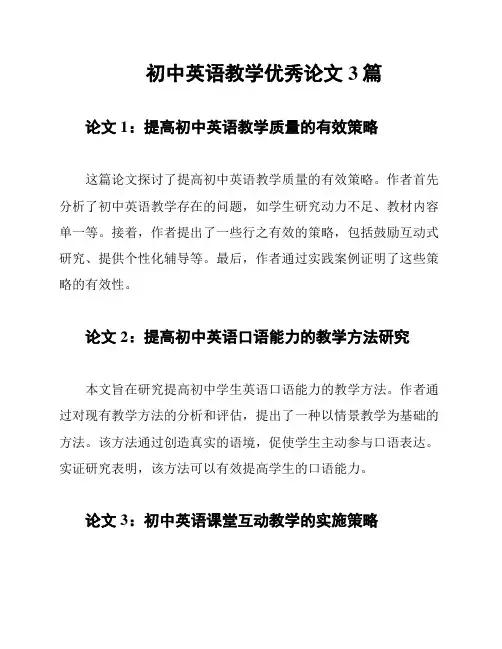
初中英语教学优秀论文3篇
论文1:提高初中英语教学质量的有效策略
这篇论文探讨了提高初中英语教学质量的有效策略。
作者首先分析了初中英语教学存在的问题,如学生研究动力不足、教材内容单一等。
接着,作者提出了一些行之有效的策略,包括鼓励互动式研究、提供个性化辅导等。
最后,作者通过实践案例证明了这些策略的有效性。
论文2:提高初中英语口语能力的教学方法研究
本文旨在研究提高初中学生英语口语能力的教学方法。
作者通过对现有教学方法的分析和评估,提出了一种以情景教学为基础的方法。
该方法通过创造真实的语境,促使学生主动参与口语表达。
实证研究表明,该方法可以有效提高学生的口语能力。
论文3:初中英语课堂互动教学的实施策略
这篇论文介绍了初中英语课堂互动教学的实施策略。
作者提出了一套可行的策略,包括采用小组活动、引入多媒体资源等。
通过实际教学案例的分析,作者证明了这些策略能够激发学生的研究兴趣,提高课堂互动效果。
以上是三篇关于初中英语教学的优秀论文的简要介绍,希望对您有所帮助。
如需详细内容,请查阅相关文献。
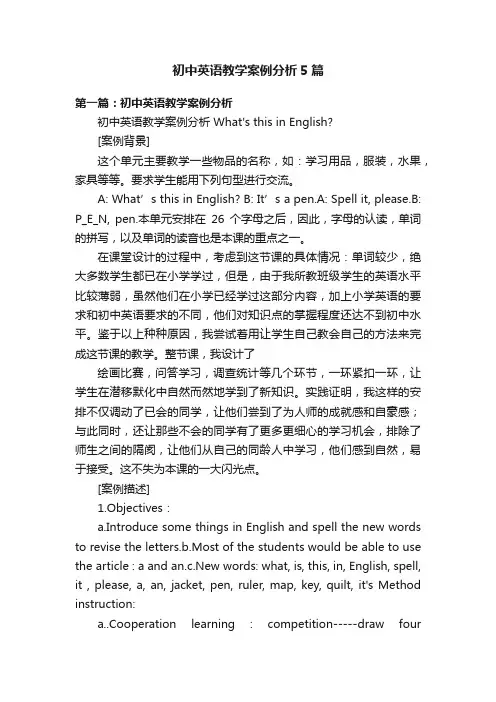
初中英语教学案例分析5篇第一篇:初中英语教学案例分析初中英语教学案例分析 What's this in English?[案例背景]这个单元主要教学一些物品的名称,如:学习用品,服装,水果,家具等等。
要求学生能用下列句型进行交流。
A: What’s this in English? B: It’s a pen.A: Spell it, please.B: P_E_N, pen.本单元安排在26个字母之后,因此,字母的认读,单词的拼写,以及单词的读音也是本课的重点之一。
在课堂设计的过程中,考虑到这节课的具体情况:单词较少,绝大多数学生都已在小学学过,但是,由于我所教班级学生的英语水平比较薄弱,虽然他们在小学已经学过这部分内容,加上小学英语的要求和初中英语要求的不同,他们对知识点的掌握程度还达不到初中水平。
鉴于以上种种原因,我尝试着用让学生自己教会自己的方法来完成这节课的教学。
整节课,我设计了绘画比赛,问答学习,调查统计等几个环节,一环紧扣一环,让学生在潜移默化中自然而然地学到了新知识。
实践证明,我这样的安排不仅调动了已会的同学,让他们尝到了为人师的成就感和自豪感;与此同时,还让那些不会的同学有了更多更细心的学习机会,排除了师生之间的隔阂,让他们从自己的同龄人中学习,他们感到自然,易于接受。
这不失为本课的一大闪光点。
[案例描述]1.Objectives:a.Introduce some things in English and spell the new words to revise the letters.b.Most of the students would be able to use the article : a and an.c.New words: what, is, this, in, English, spell, it , please, a, an, jacket, pen, ruler, map, key, quilt, it's Method instruction:a..Cooperation learning : competition-----draw fourpictures(each team a picture about school things, fruit , clothes and furniture(five minutes)b.show them in class.Then the teacher asked : What's this in English? Who knows? Please hands up!Then let the students who have learnt the new words teach the others.c.Let the whole class repeat the new words several times..Pay attention to the article: a and and.Cooperation leaning: Make a survey;learn the English of the other things they draw and write down the English names beside the things they drew.Agree them to ask the students in other groups if all the students in their group don't know the words.e.Show the words they write on the blackboard by 实物投影。
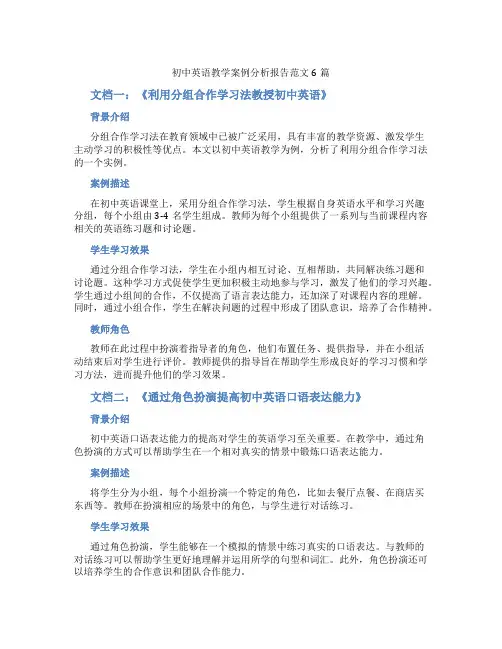
初中英语教学案例分析报告范文6篇文档一:《利用分组合作学习法教授初中英语》背景介绍分组合作学习法在教育领域中已被广泛采用,具有丰富的教学资源、激发学生主动学习的积极性等优点。
本文以初中英语教学为例,分析了利用分组合作学习法的一个实例。
案例描述在初中英语课堂上,采用分组合作学习法,学生根据自身英语水平和学习兴趣分组,每个小组由3-4名学生组成。
教师为每个小组提供了一系列与当前课程内容相关的英语练习题和讨论题。
学生学习效果通过分组合作学习法,学生在小组内相互讨论、互相帮助,共同解决练习题和讨论题。
这种学习方式促使学生更加积极主动地参与学习,激发了他们的学习兴趣。
学生通过小组间的合作,不仅提高了语言表达能力,还加深了对课程内容的理解。
同时,通过小组合作,学生在解决问题的过程中形成了团队意识,培养了合作精神。
教师角色教师在此过程中扮演着指导者的角色,他们布置任务、提供指导,并在小组活动结束后对学生进行评价。
教师提供的指导旨在帮助学生形成良好的学习习惯和学习方法,进而提升他们的学习效果。
文档二:《通过角色扮演提高初中英语口语表达能力》背景介绍初中英语口语表达能力的提高对学生的英语学习至关重要。
在教学中,通过角色扮演的方式可以帮助学生在一个相对真实的情景中锻炼口语表达能力。
案例描述将学生分为小组,每个小组扮演一个特定的角色,比如去餐厅点餐、在商店买东西等。
教师在扮演相应的场景中的角色,与学生进行对话练习。
学生学习效果通过角色扮演,学生能够在一个模拟的情景中练习真实的口语表达。
与教师的对话练习可以帮助学生更好地理解并运用所学的句型和词汇。
此外,角色扮演还可以培养学生的合作意识和团队合作能力。
教师在角色扮演中既是引导者,也是参与者。
他们需要起到积极引导学生参与角色扮演的作用,并及时给予学生反馈和指导。
教师还可以在角色扮演活动结束后进行整体的总结和评价。
文档三:《利用多媒体教具提高初中英语听力能力》背景介绍初中英语听力是学生英语学习中的重要环节。
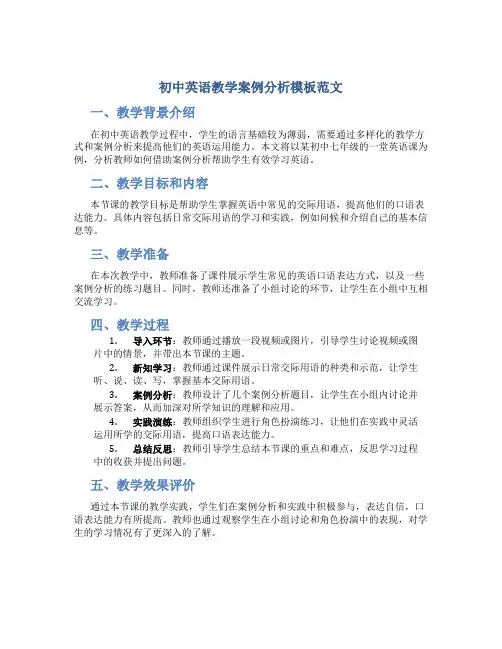
初中英语教学案例分析模板范文一、教学背景介绍在初中英语教学过程中,学生的语言基础较为薄弱,需要通过多样化的教学方式和案例分析来提高他们的英语运用能力。
本文将以某初中七年级的一堂英语课为例,分析教师如何借助案例分析帮助学生有效学习英语。
二、教学目标和内容本节课的教学目标是帮助学生掌握英语中常见的交际用语,提高他们的口语表达能力。
具体内容包括日常交际用语的学习和实践,例如问候和介绍自己的基本信息等。
三、教学准备在本次教学中,教师准备了课件展示学生常见的英语口语表达方式,以及一些案例分析的练习题目。
同时,教师还准备了小组讨论的环节,让学生在小组中互相交流学习。
四、教学过程1.导入环节:教师通过播放一段视频或图片,引导学生讨论视频或图片中的情景,并带出本节课的主题。
2.新知学习:教师通过课件展示日常交际用语的种类和示范,让学生听、说、读、写,掌握基本交际用语。
3.案例分析:教师设计了几个案例分析题目,让学生在小组内讨论并展示答案,从而加深对所学知识的理解和应用。
4.实践演练:教师组织学生进行角色扮演练习,让他们在实践中灵活运用所学的交际用语,提高口语表达能力。
5.总结反思:教师引导学生总结本节课的重点和难点,反思学习过程中的收获并提出问题。
五、教学效果评价通过本节课的教学实践,学生们在案例分析和实践中积极参与,表达自信,口语表达能力有所提高。
教师也通过观察学生在小组讨论和角色扮演中的表现,对学生的学习情况有了更深入的了解。
六、教学反思与改进在教学过程中,教师发现学生在角色扮演中还存在一些语法错误和表达不够准确的情况,因此在下节课中将加强对语法知识的讲解,帮助学生更好地理解交际用语背后的语言规则。
以上是初中英语教学案例分析的模板范文,希望对初中英语教师在教学实践中有所帮助。
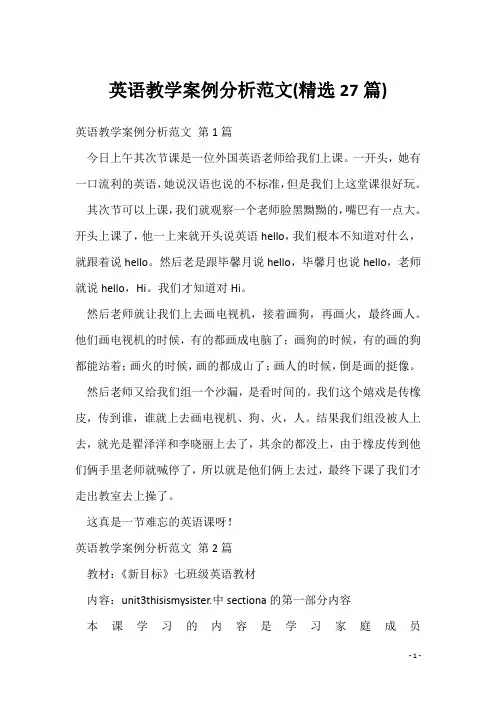
英语教学案例分析范文(精选27篇)英语教学案例分析范文第1篇今日上午其次节课是一位外国英语老师给我们上课。
一开头,她有一口流利的英语,她说汉语也说的不标准,但是我们上这堂课很好玩。
其次节可以上课,我们就观察一个老师脸黑黝黝的,嘴巴有一点大。
开头上课了,他一上来就开头说英语hello,我们根本不知道对什么,就跟着说hello。
然后老是跟毕馨月说hello,毕馨月也说hello,老师就说hello,Hi。
我们才知道对Hi。
然后老师就让我们上去画电视机,接着画狗,再画火,最终画人。
他们画电视机的时候,有的都画成电脑了;画狗的时候,有的画的狗都能站着;画火的时候,画的都成山了;画人的时候,倒是画的挺像。
然后老师又给我们组一个沙漏,是看时间的。
我们这个嬉戏是传橡皮,传到谁,谁就上去画电视机、狗、火,人。
结果我们组没被人上去,就光是翟泽洋和李晓丽上去了,其余的都没上,由于橡皮传到他们俩手里老师就喊停了,所以就是他们俩上去过,最终下课了我们才走出教室去上操了。
这真是一节难忘的英语课呀!英语教学案例分析范文第2篇教材:《新目标》七班级英语教材内容:unit3thisismysister.中sectiona的第一部分内容本课学习的内容是学习家庭成员(father,mother,parent,grandfather,grandmother,grandparent等)并学会向他人介绍自己的家庭成员(.),情境刺激-英语教学案例分析。
由于同学学校学习过家庭成员的英文单词,所以笔者把重点用于教同学如何介绍自己的家庭成员,这一部分也正是同学感爱好的话题。
英语教学案例分析范文第3篇一、前言:在实施新《课程标准》进展素养教育的今日,体育课堂教学不再是传统单调、枯燥的学习氛围,而是要通过教学让同学充分展现、体现自我。
充分体现一个中心、四个特点。
以让同学自动学习,乐观实践,努力创新为中心,结合体育学科突出四个特点。
特殊是对学校低班级同学来说,通过唱游形式进行体育教学,达到教学目的,提高学习成果,激发学习爱好,已逐步成为体育老师一种行之有效的教学**。
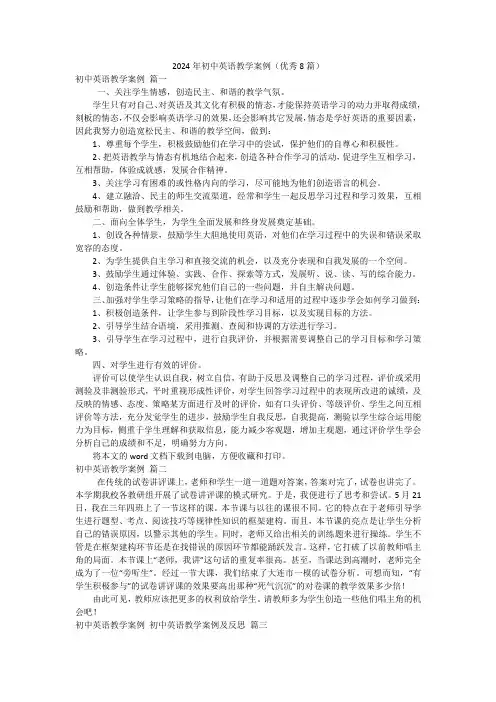
2024年初中英语教学案例(优秀8篇)初中英语教学案例篇一一、关注学生情感,创造民主、和谐的教学气氛。
学生只有对自己、对英语及其文化有积极的情态,才能保持英语学习的动力并取得成绩,刻板的情态,不仅会影响英语学习的效果,还会影响其它发展,情态是学好英语的重要因素,因此我努力创造宽松民主、和谐的教学空间,做到:1、尊重每个学生,积极鼓励他们在学习中的尝试,保护他们的自尊心和积极性。
2、把英语教学与情态有机地结合起来,创造各种合作学习的活动,促进学生互相学习,互相帮助,体验成就感,发展合作精神。
3、关注学习有困难的或性格内向的学习,尽可能地为他们创造语言的机会。
4、建立融洽、民主的师生交流渠道,经常和学生一起反思学习过程和学习效果,互相鼓励和帮助,做到教学相关。
二、面向全体学生,为学生全面发展和终身发展奠定基础。
1、创设各种情景,鼓励学生大胆地使用英语,对他们在学习过程中的失误和错误采取宽容的态度。
2、为学生提供自主学习和直接交流的机会,以及充分表现和自我发展的一个空间。
3、鼓励学生通过体验、实践、合作、探索等方式,发展听、说、读、写的综合能力。
4、创造条件让学生能够探究他们自己的一些问题,并自主解决问题。
三、加强对学生学习策略的指导,让他们在学习和适用的过程中逐步学会如何学习做到:1、积极创造条件,让学生参与到阶段性学习目标,以及实现目标的方法。
2、引导学生结合语境,采用推测、查阅和协调的方法进行学习。
3、引导学生在学习过程中,进行自我评价,并根据需要调整自己的学习目标和学习策略。
四、对学生进行有效的评价。
评价可以使学生认识自我,树立自信,有助于反思及调整自己的学习过程,评价或采用测验及非测验形式,平时重视形成性评价,对学生回答学习过程中的表现所改进的诚绩,及反映的情感、态度、策略某方面进行及时的评价,如有口头评价、等级评价、学生之间互相评价等方法,充分发觉学生的进步,鼓励学生自我反思,自我提高,测验以学生综合运用能力为目标,侧重于学生理解和获取信息,能力减少客观题,增加主观题,通过评价学生学会分析自己的成绩和不足,明确努力方向。
2023年初中英语教学案例初中英语教学案例及反思优秀5篇初中英语教学案例初中英语教学案例及反思篇一本话题是仁爱英语八年级上册第二单元的第二个话题,主要学习个人卫生和饮食健康等内容,也是中考中一个重要的。
话题。
本话题主要通过谈论如何养成良好习惯,保持健康,学习掌握重要句型和词汇;并通过阅读有关饮食健康的文章,引入更多的词汇,同时学会运用简单的阅读策略获取信息和学会保持良好的习惯。
最后以project探究形式对所学内容进行运用,培养学生的综合语言运用能力。
即是能将所学的语言组织起来,写成语句连贯、表意准确的短文。
1.学会描述良好的生活习惯。
2.根据所学的词或词组,写出关于如何保持健康的重要性并给出好的建议的文章。
描述出保持健康的方法,以及自己的看法。
step 1. lead in: 通过讨论下面的问题,引出本节课的大任务。
吸引学生,激发其学习兴趣,提高学生作为学习主体课堂参与意识。
列一个目录在黑板1. how often do you exercise ?2. how often do you eat vegetables?3. how often do you eat fruit ?4. how many hours do you sleep every night ?5. how often do you drink milk ?6. how often do you eat junk food ?7. how often do you drink coffee ?step on 让学生先以小组的形式复习section a 和section b的内容,使用大脑风暴法(让学生brainstorm)说出一些食物名称和healthy 有关的单词短语和句子,目的是激活学生头脑中和写作话题keep healthy 相关的东西来酝酿写作的思路,以便写作时能选择有意义的东西。
同时通过ppt出示一些good habits or bad habits及一些建议的短语:taking a walk after meals. taking a walk after meals. drinking enough water every day. washing hands before meals eating too much meat. going to bed late and getting up late.throwing litter around.going to school without breakfast problems: unhealthy advice 1. should eat a lot of vegetables 2. should eat a lot of fruits 3. can drink milk every day 4. don’t drink coffee 5. shouldn’t eat junk food se every day have eight hours’ sleep ’t play computer games or watch tv too muchstep3. 展示作文题目,指导学生如何谋篇布局,规划文章结构,起草文章,组织语言。
初中英语教学案例分析
初中英语教学案例分析
一、教学案例写作基础
教师具有一定的教学基础理论,一定的写作基础知识,一定的教学教研经验,一定的分析研究能力。
总之,教师具备写作教学案例的基础。
只要教师认真研究,都有可能写出有价值的教学案例。
只要认真地运用教学理论深入分析教学案例,都有可能提出独到的见解。
撰写教学案例与撰写教学论文相比,写成的可能性,写好的可能性,获奖的可能性,发表的可能性,都要大得多。
二、初中英语教学案例分析(精选10篇)
案例,就是人们在生产生活当中所经历的典型的富有多种意义的事件陈述。
它是人们所经历的故事当中的有意截取。
下面是小编为大家整理的初中英语教学案例分析(精选10篇),仅供参考,希望能
够帮助到大家。
摘要:
主要阐述了在农村初中英语教学中,如何创造有利于学生学习的心理状态,形成积极的学习态度,课堂教学中如何发挥英语学科的思想性和人文性,体现育人价值。
通过教师有效运用各种激励方法,培养学生积极的学习心向,构建和谐的师生关系,整体提高英语教学效益,努力促进学生智商和情商的发展。
关键词:
主动学习;初中英语;英语教学。
九年级英语教学案例分析范文6篇Teaching English to Grade 9 students can be a challenging yet rewarding experience. At this stage, students are transitioning from middle school to high school and are expected to develop more advanced language skills. As an English teacher, it is crucial to design and implement effective lesson plans that cater to the diverse needs and learning styles of Grade 9 students. In this essay, we will explore six sample English teaching case studies for Grade 9 that can serve as a valuable reference for educators.Case Study 1: Improving Reading ComprehensionIn this case study, the focus is on enhancing the reading comprehension skills of Grade 9 students. Many students at this level struggle with understanding complex literary texts, such as novels, short stories, and poetry. The teacher recognized this challenge and decided to implement a structured approach to improve their reading skills.The lesson plan began with an introduction to the selected text, where the teacher provided background information and context tohelp students better understand the content. Next, the teacher utilized various strategies to engage students in active reading, such as asking guiding questions, encouraging them to make predictions, and highlighting key literary devices.During the reading process, the teacher encouraged students to take notes, annotate the text, and engage in discussions with their peers. This collaborative approach allowed students to share their interpretations, ask questions, and gain a deeper understanding of the text.To further reinforce the reading comprehension skills, the teacher assigned follow-up activities, such as written summaries, literary analysis essays, and oral presentations. These assignments not only assessed the students' understanding but also provided opportunities for them to develop their critical thinking and communication skills.The results of this case study were promising, as the students demonstrated significant improvements in their ability to comprehend and analyze literary texts. The teacher's use of a structured approach, active reading strategies, and diverse assessment methods contributed to the students' overall growth in reading comprehension.Case Study 2: Developing Effective Writing SkillsIn this case study, the focus is on helping Grade 9 students develop their writing skills. Many students at this level struggle with organizing their thoughts, expressing their ideas clearly, and adhering to the conventions of academic writing.The teacher began by introducing the writing process, emphasizing the importance of prewriting, drafting, revising, and editing. Students were guided through various prewriting activities, such as brainstorming, outlining, and researching, to help them generate and organize their ideas.During the drafting stage, the teacher provided explicit instruction on the elements of effective writing, including thesis statements, topic sentences, supporting details, and transitions. Students were encouraged to experiment with different writing styles and structures, depending on the assigned task (e.g., persuasive essay, narrative, research paper).To promote peer learning and feedback, the teacher incorporated peer-review sessions, where students exchanged their drafts and provided constructive criticism to one another. This process allowed students to receive valuable feedback and refine their writing before the final submission.The teacher also emphasized the importance of revision and editing, guiding students through the process of improving their work based on the feedback received. Students were taught to identify and correct common writing errors, such as grammar, punctuation, and spelling mistakes.The results of this case study were positive, as the students demonstrated significant improvements in their writing skills. They were able to organize their thoughts more effectively, express their ideas more clearly, and adhere to the conventions of academic writing. The structured approach to the writing process, combined with targeted feedback and revision opportunities, contributed to the students' overall growth as writers.Case Study 3: Enhancing Oral Communication SkillsIn this case study, the focus is on developing the oral communication skills of Grade 9 students. Many students at this level struggle with public speaking, expressing their thoughts clearly, and engaging in meaningful discussions.The teacher recognized the importance of oral communication skills in academic and professional settings and decided to incorporate various activities and strategies to help students improve in this area.The lesson plan began with an introduction to the principles ofeffective public speaking, such as body language, eye contact, and vocal variety. Students were given opportunities to practice these skills through short presentations, debates, and group discussions.To build confidence and reduce anxiety, the teacher encouraged a supportive and collaborative classroom environment. Students were encouraged to provide constructive feedback to their peers and to actively participate in discussions.The teacher also incorporated role-playing activities, where students were assigned different personas or scenarios to practice their communication skills. This approach allowed students to experiment with different communication styles and receive feedback on their performance.To further enhance their oral communication skills, the teacher assigned project-based learning activities that required students to work in teams and present their findings to the class. This not only developed their presentation skills but also their ability to collaborate and communicate effectively with their peers.The results of this case study were encouraging, as the students demonstrated significant improvements in their oral communication skills. They became more confident in public speaking, more adept at expressing their thoughts clearly, and more engaged in classdiscussions. The structured approach to developing these skills, combined with opportunities for practice and feedback, contributed to the students' overall growth in this area.Case Study 4: Integrating Technology in the ClassroomIn this case study, the focus is on integrating technology in the Grade 9 English classroom to enhance the learning experience. Many students at this level are digital natives and are comfortable with various technological tools, so the teacher decided to leverage this familiarity to engage students and improve their learning outcomes.The lesson plan incorporated the use of multimedia resources, such as educational videos, interactive presentations, and online learning platforms. The teacher carefully selected these resources to align with the curriculum and to provide students with engaging and informative content.To encourage active learning, the teacher incorporated technology-based activities, such as online quizzes, collaborative document editing, and virtual discussions. These activities allowed students to interact with the content, apply their knowledge, and receive immediate feedback.The teacher also encouraged students to use technology for research, writing, and presentation purposes. Students were given theopportunity to use online databases, word processing software, and presentation tools to complete their assignments and projects.To ensure the effective integration of technology, the teacher provided clear instructions and guidance on the use of these tools. Students were also encouraged to share their knowledge and experiences with their peers, fostering a collaborative learning environment.The results of this case study were positive, as the students demonstrated increased engagement, motivation, and learning outcomes. The integration of technology not only made the learning process more interactive and enjoyable but also helped students develop essential digital literacy skills.Case Study 5: Differentiated Instruction for Diverse LearnersIn this case study, the focus is on implementing differentiated instruction to address the diverse learning needs of Grade 9 students. In any given classroom, there is a wide range of learning styles, abilities, and backgrounds, and the teacher recognized the importance of adapting the instruction to cater to these differences.The lesson plan incorporated various instructional strategies and materials to accommodate the diverse learners in the classroom. This included providing different levels of text complexity, offeringalternative assignment options, and utilizing a variety of teaching methods (e.g., direct instruction, group work, independent learning).The teacher also incorporated formative assessments throughout the lessons to gauge the students' understanding and to identify areas where they needed additional support. Based on this information, the teacher provided targeted interventions and scaffolding to help students overcome their challenges.To promote inclusivity and support, the teacher fostered a collaborative learning environment where students were encouraged to work together, share their strengths, and support one another. This approach not only helped struggling students but also challenged the high-achieving students to take on more complex tasks and to mentor their peers.The results of this case study were positive, as the students demonstrated improved learning outcomes and increased engagement in the classroom. The differentiated instruction approach allowed the teacher to meet the diverse needs of the students, resulting in a more inclusive and effective learning environment.Case Study 6: Fostering Cross-Cultural UnderstandingIn this case study, the focus is on fostering cross-culturalunderstanding in the Grade 9 English classroom. As students navigate the transition to high school, it is important to help them develop a deeper appreciation for diversity and a global perspective.The teacher recognized the importance of exposing students to different cultures, perspectives, and experiences through the study of literature, media, and current events. The lesson plan incorporated the use of diverse texts, such as short stories, poems, and articles, that represented a range of cultural backgrounds and experiences.The teacher facilitated discussions and activities that encouraged students to compare and contrast the cultural elements present in the texts, to reflect on their own cultural identities, and to engage in respectful dialogue with their peers.To further enhance cross-cultural understanding, the teacher invited guest speakers, organized field trips to cultural events, and encouraged students to participate in cultural exchange programs. These experiences allowed students to directly engage with diverse perspectives and to develop a more nuanced understanding of the world around them.The teacher also incorporated project-based learning activities that required students to research and present on different cultures, traditions, and global issues. This approach not only deepened theirknowledge but also developed their critical thinking and communication skills.The results of this case study were positive, as the students demonstrated increased cultural awareness, empathy, and respect for diversity. They were able to engage in meaningful discussions, challenge their own biases, and develop a more global perspective. The integration of diverse texts, cultural experiences, and project-based learning contributed to the students' overall growth in cross-cultural understanding.In conclusion, these six sample English teaching case studies for Grade 9 provide valuable insights into the effective strategies and approaches that can be implemented in the classroom. By addressing the diverse needs of students, incorporating technology, fostering cross-cultural understanding, and promoting active learning, teachers can create a dynamic and engaging learning environment that supports the academic and personal growth of Grade 9 students.。
初中英语教学案例分析一、案例简介在初中英语教学中,教师面临着来自不同学生的各种教学挑战。
本文将针对某一实际教学案例展开分析,以期深入探讨如何更好地应对教学中遇到的问题,并提出解决方案。
二、案例分析某初中九年级英语班级中,有一位叫小明的学生英语成绩一直较差,尤其是在英语听力方面。
在课堂上,小明总是听不清楚老师的发音,也无法完全理解教师的英语口语表达。
在课后作业中,小明的口语表达和写作能力又相对较弱,总是出现语法错误和用词不当的问题。
针对这一案例,教师需要仔细分析问题的原因,以制定有效的教学策略。
1. 听力问题:小明可能存在听力方面的困难,这可能是由于他在英语学习初期没有进行充分的英语听力训练,导致对英语语音和语调的掌握不够准确。
也可能是由于小明在平时生活中对英语听力的接触较少,导致对于英语口语的理解存在障碍。
2. 口语表达和写作问题:小明的口语表达和写作能力较弱,可能是由于他在语法和词汇方面的掌握不够扎实,同时也可能是由于他缺乏练习的机会。
三、解决方案针对小明的问题,教师可以采取以下解决方案:1. 加强听力训练:教师可以通过多媒体设备或者英语听力教材,为小明提供更多的听力训练机会。
在课堂上也可以采取听力练习的形式,让小明在积极的氛围中进行英语听力练习,提高他的听力水平。
2. 提供口语和写作练习:教师可以设计口语和写作练习,让小明积极参与,提高他的口语表达和写作能力。
教师也可以为小明提供更多关于语法和词汇掌握的帮助,让他的语言基础更加扎实。
3. 鼓励学生参与:教师在课堂上可以鼓励小明积极参与英语讨论和交流,给予他更多的表扬和鼓励,让他在英语学习中充满自信,提高学习积极性。
四、效果评估经过一段时间的教学实践,教师可以对小明的学习情况进行评估,以了解教学效果。
1. 听力提高:通过观察小明的听力训练练习和课堂表现,教师可以判断小明的听力是否有所提高。
可以通过听力测试等形式来进行客观评估。
2. 口语表达和写作提高:通过小明的口语表达和写作练习,教师可以了解小明在口语和写作方面是否有所改善。
初中英语教学设计与案例分析(大全五篇)第一篇:初中英语教学设计与案例分析初中英语教学设计与案例分析回龙中学初中英语(人教版)七年级下册Unit5第一课时教学设计我此次分析的课是我在东南片区教研磨课中教学的一堂课,以下是我的具体内容:设计思路本节课教授的词汇主要是动物名称类的,谈论喜欢动物的原因,用why 和because 对话,涉及let’s ….句型。
课型属于听说课。
在课前先营造一种轻松的学习氛围,教唱一首英语歌曲,little tigers是让学生尽快地融入进课堂,期间还有pair work,group work,把学生分成六人小组,互相对话。
教材分析本节课是第5单元的第一课时,学生在上册书学过原因结果的英语知识之后,进一步地在本单元学习有关谈论动物喜好的知识。
而本课时是第一课时,所授的知识点应该浅显易懂,不应该太难。
本课时围绕着动物的词汇和why、because的句型展开。
词汇首当其冲,在学习词汇之后,句型的教授也应该把握重点,本课时的主要句型是Let’s see….first.Why do you like …? Because…..词汇的重点是关于动物的词汇和形容动物特征的形容词。
教学目标(一)教学知识点(1)New words:tiger ,panda, lion , elephant, koalos, giraffe, ….(2)Questions and answers:Let’s see….first.Why do you like …? Because it’s they’re….二)能力训练要求(1)通过师生对话,生生对话等一系列活动,提高学生实际运用英语的能力。
(2)体会合作学习所带来的快乐。
(三)情感与价值观要求通过学生互相帮助,互相学习,体验爱动物,爱生活,爱我们自己的精神。
教学重点和难点重点:(1)学会重点词汇的发音,单复数形式的掌握。
(2)学会询问原因句型及其回答。
英语教学论文范文(精选6篇)(4)一、任务型教学法在初中英语课堂中的应用研究摘要:随着我国英语教学改革的不断深入,任务型教学法作为一种有效的教学方法,逐渐受到广大英语教师的关注。
本文以初中英语课堂为研究对象,探讨任务型教学法在实践中的应用及其成效。
1. 任务型教学法的概述任务型教学法(Taskbased Language Teaching,简称TBLT)是一种以任务为核心的教学模式,强调学生在完成任务的过程中自然习得语言。
这种教学法主张将语言学习与实际生活相结合,让学生在真实语境中运用英语,提高他们的语言运用能力。
2. 任务型教学法在初中英语课堂的应用实例案例一:《新目标英语》七年级上册Unit 7 “How much are these socks?”(1)任务设计:教师设计了一个“购物”任务,让学生在模拟的购物场景中运用本单元所学词汇和句型进行交流。
(2)任务实施:将学生分成若干小组,每组扮演不同的角色(顾客、售货员等)。
学生在完成任务的过程中,需要运用目标语言进行沟通,达成购物目标。
(3)任务评价:教师根据学生在任务过程中的表现,评价他们的语言运用能力、团队协作能力和问题解决能力。
3. 任务型教学法在初中英语课堂的应用成效(1)提高学生的英语学习兴趣:任务型教学法将课堂知识与实际生活相结合,使学生在轻松愉快的氛围中学习英语,增强了他们的学习兴趣。
(2)培养学生的语言运用能力:通过完成各种任务,学生将所学知识应用于实际情境,提高了他们的英语口语和听力水平。
(3)增进学生之间的合作与交流:任务型教学法强调团队合作,学生在完成任务的过程中,相互帮助、共同进步,增进了彼此间的友谊。
4. 结论任务型教学法在初中英语课堂中的应用具有显著成效,有助于提高学生的英语学习兴趣和语言运用能力。
教师在实际教学中,应根据学生的实际情况和教学内容,灵活设计任务,以充分发挥任务型教学法的优势。
二、任务型教学法在初中英语课堂中的应用策略1. 注重任务的真实性在设计任务时,教师应确保任务的真实性,使其贴近学生的生活实际。
初中英语教学案例分析
我们教师在教学活动中要善于总结,善于应用,才能不断地推进教学活动的开展。
教学案例(一):单词的教学。
在单词教学中如何变单一为多样,变死板为生动? 我
在教授单词的过程中十分注重单词的使用语境, 如在教授cook和cooker这两个单词的时候,我分别出示了几张图片(一些橱具和两位橱师),让学生通过对图片的直观感知,从第一印象开始就对他们有一个清晰而明确的认识, 从而避免了对这两个词汇的混淆。
然后再通过"He is a good cook, he has a lot of cookers."这样的例句加深学生对他们的理解和运用。
在教学invent单词时,让学生连带掌握相关单词,通过举例句:The great inventor invented lots of inventions.知识浓缩后易于学生理解记忆。
教学反思:由于教材词汇量大,单词长,生僻词较多,自然也就增加了教学的难度,但我们又必须让学生掌握,否则难以适应新教材的要求。
那么我们该采取什么方式来教学单词呢?美国学者埃克斯雷指出:“能够引起学生学习兴趣的方法就是最好的方法。
”实践证明,拼图法,数字游戏,单词接龙游戏,小歌诀,顺口溜等传统教学方法并不过时,教师再辅以现代化的教学手段,借助图片,幻灯片,动漫等手段,真正达到重情景,重趣味,重运用,使单词具有语言的意义,使其在特定的语境中被引出,这样既便于学生理解,印象也深刻,从而达到学以致用的效果。
在英语教学中适时地加入这些美味的“作料”,无疑是一种优化组合的创新,它不但能极大的激发学生的学习兴趣,更能提高学生的学习积极性.
教学案例(二):结合实际操练对话。
如何把英语对话教学引入到生活中,达到学以致用?中国学生的英语学习现状是往往学习了几年,甚至是十几年的英语,还不能开口说英语,而只能纸上谈兵.我在教学中十分注重学生对对话的理解和运用,但在实际的操作中效果并不理想.如我在教授"A:Are you free this Sunday ? B: No, I'm afraid I have no time . A: How about tomorrow? B: OK, I have time then .What's up? A: Let's go to the zoo. B: Sounds great. A: What animals do you like best? B: I like lions. They are strong. A: How about you ? B: I like pandas , they are cute." 这个对话,在第二天提问时,学生的背诵情况很好,但当我要求他们重新组织一个对话时,效果不尽人意.要么两人一组的搭配不合适,按照固定的座位进行操练,有的搭配过于悬殊,开展不了对话;要么只会运用近期的知识点,稍微久远的就遗忘。
教学反思:针对以上所出现的现象,我认为创设情景,营造英语氛围,充分发挥学生学习的主动性是至关重要的。
从单词教学到对话独立运用,整个过程处处注意创设情景,营造轻松愉快的课堂氛围;充分发挥道具和肢体动作,进入角色对话。
在操练过程中,充分注意到对不同层次的学生提出不同的要求,因材施教。
改变按照固定座位进行操练的传统做法,让学生自由搭配,这样就满足了不同层次学生的需要.对于基础较差的学生,让好学生做示范,反复操练,这样就避免了会出现好学生越好,差学生越差的现象“每节课堂五分钟,英语口语带回家”,短短的五分钟,不但让学生张开了嘴,还让他们争先恐后的去尝试,去演练,去表演,极大地帮助他们树立了学好英语的信心,创设机会让他们去体验成功的快乐。
没有什么东西比成功更能增加满足的感觉,也没有什么东西比成功更能鼓起进一步追求成功的努力。